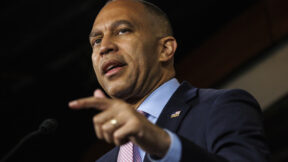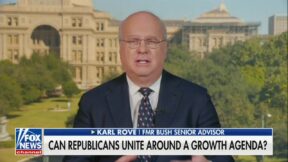Elizabeth Warren Ad Laments Loss of ‘The America I Grew Up In’ for Students; She Earned Scholarship at Segregated School
Massachusetts Senator and Democratic presidential candidate Elizabeth Warren lamented that “the America I grew up in” would not be available to her grandchildren in an ad about educational opportunity. But Warren earned a full scholarship at a high school that banned black students.
The ad is entitled “Elizabeth Warren Has Been Warning About the Student Debt Crisis for Years,” and features clips from a 2007 interview in which then-professor Warren talks about educational opportunity, and notes that “the children of well-to-do families, who can afford to pay for the college education for their children, have a leg up. They start their adult lives, if nothing else, at least dead flat broke — right? — at least at even.”
The ad cuts to Warren remarking that “the America that I knew, that I grew up in, will be something that will be confined to the history books. It won’t be there for my grandchildren.”, referring to the ability to attend college without racking up a mountain of debt.
But the “America I grew up in” also included the high school at which Warren earned the sweet scholarship she described elsewhere in that interview.
“I was sixteen years old when I graduated from high school and I got a full scholarship in debate that was room, board, tuition, books and a little spending money,” Warren said, and added “It was a fabulous scholarship at George Washington University, if I would debate for them.”
But Warren had another “leg up,” albeit one that remains unknown to most people because Warren never speaks about it, and the media almost never reports it — and does so inaccurately when they do.
Northwest Classen High School was a segregated school that did not admit any black students, a fact that was reported in 2012 as part of a lengthy Boston Globe profile. That report, like a tiny handful of others by the same reporter — Noah Bierman — incorrectly stated that while Warren was at Northwest Classen, “the state was still completely segregated.”
It has been amended since my first report on this subject, and now states “Long after the Supreme Court ordered schools desegregated in 1955, Northwest Classen remained all white. Hers was the last era before Oklahoma would be riled by school busing that would integrate and transform her school.”
Even in that report, Warren was not directly quoted on the subject, and it’s unclear on what Bierman based his assertion that Oklahoma was “completely segregated” in 1966, but the claim appears designed to make it seem as though Warren’s parents — who deliberately selected their home to get Warren into that school — had no choice but to send her to an all-white school.
That’s not true, though. Oklahoma City began integrating schools in 1955, although they did so in a way that viciously violated the spirit of Brown v. Board of Education. They designed a policy that allowed them to maintain several all-white schools, including Warren’s school, and transfer black students in those districts to integrated schools using pretexts.
“All-white” is also a bit of a misnomer; Warren did graduate with three or four people of color. It was black students who were not allowed.
Although Warren obviously couldn’t control where her parents moved or what public school they sent her to, it seems unlikely that she was unaware of the school’s status, and impossible that she hasn’t learned about it since. And whether she controlled it or not, the benefit she derived from attending a school that kept her from competing with black students is tangible, and her family actively sought that benefit, a “ticket to success” at a school that was known to be the best in the state.
Yet when discussing students getting a “leg up” on educational opportunity, or when telling the story of her mother’s heartbreaking journey to Sears to keep Warren in that school, or at any other time in public, it has never occurred to Warren to mention it. Not even once.
Not even now. The Warren campaign declined to comment on this issue, but they did respond to questions about another aspect of this story, a strange one. Warren said, in that 2007 interview, that she was awarded a scholarship that covered all her expenses and then some, and in a 2008 town hall meeting with Bernie Sanders, told the crowd that she went to school on “some scholarships,” and added “I was in the lucky years, before they loaded you down with a lot of student debt.”
But Warren claimed in her 2014 book A Fighting Chance that she left GWU in debt.
“I now had what Jim jokingly called a ‘reverse dowry’ — I owed money on my student loans from GW, even though I hadn’t gotten a diploma,” Warren wrote, referring to her then-husband Jim Warren, and added “But I had a plan. If I could finish college and get a teaching job, I could make a steady salary and the government would forgive some of those loans every year.”
And in 2017, Warren wrote that GWU offered her “a full scholarship and a federal loan.”
In her 2002 book The Two Income Trap, Warren added a third source of funding for the GWU education that she gave up: that job at Sears that her mother had taken to keep her in the Northwest Classen school district.
“When I was a senior in high school, she talked about quitting, but she decided to keep working so that she and my father could help with the cost of my college tuition,” Warren wrote.
A spokesperson for the Warren campaign referred me to A Fighting Chance, and added “As she has said, Elizabeth got a full scholarship to George Washington University. She took out student loans and worked to help cover non-tuition costs. As most people know, the costs of being a full-time student go beyond tuition, which is why Elizabeth’s plan for universal college also expands pell grants to help cover non-tuition costs for public trade schools, technical colleges, 2 year colleges and 4 year colleges.”
But the campaign declined to provide any detail about the loans, or to explain what additional expenses those loans covered beyond the “room, board, tuition, books and a little spending money” that Warren said her scholarship provided.
The shifting details of Warren’s college attainment are tough to account for, as none of them feature prominently in her current pitch to voters. Having to struggle to pay student loans would seem to fit right in with her plans, and make her relatable to the voters that her policies are aimed at.
Warren’s refusal to talk about her segregated high school is less tough to figure out, if you’re in a guessing mood.
The most charitable of many uncharitable possible reasons for her silence might simply be that Warren believes it will make her look bad, that the media and her critics won’t take the nuanced view that yes, she benefited from segregation, but is fighting now to make up for something that — while beyond her control — harmed others.
But Warren is missing an opportunity to connect with a set of voters with whom she has had difficulty gaining traction by talking about the ways in which the disgrace of segregation benefited her, and how it shaped her views on racial justice, how even the story of her own struggle is dwarfed in comparison to those of Americans who were denied the opportunities she has had. They deserve a place in her story.
Watch Warren’s ad above via Elizabeth Warren for President.
This is an opinion piece. The views expressed in this article are those of just the author.




